jdowning
Oud Junkie
    
Posts: 3485
Registered: 8-2-2006
Location: Ontario, Canada
Member Is Offline
Mood: No Mood
|
|
A Question of Oud Bridge Design.
The Brussels #0164 oud may be one of the oldest surviving ouds.
It has several interesting features one being the bridge design. There are no string holes drilled in the bridge. Instead slots are cut in the bridge
to accommodate each pair of strings and additional material is added to the bridge to increase the glued 'footprint' area.
Interestingly this design of bridge is also found on some 'Baroque' guitars of the 17th C - as well as bridges that are slotted (but without the added
footprint area) found on both 16th C Spanish vihuelas and 17th C guitars.
The attached images show this style of bridge used on a French style ' Baroque' guitar that I made in 1973 (rebuilt in 1996).
This feature may imply a connection of the Brussels oud with earlier Moorish 'Spain' oud making traditions.
Has anyone come across other examples of this style of bridge on ouds?
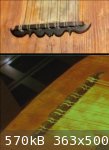
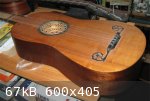
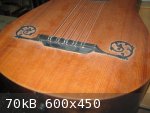
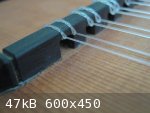
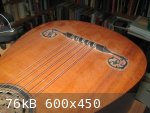
|
|
|
MatthewW
Oud Junkie
    
Posts: 1031
Registered: 11-5-2006
Location: right here
Member Is Offline
Mood: Al Salam
|
|
Hi John, this is indeed an interesting bridge design, I don't recall seeing it before. Do you think it hasn't seen more wider usage on stringed
instruments of this type becase of the spaces that are cut into the bridge where the strings are attached create weaker points on the bridge?
Is this instrument actually referred to as Brussels 0164 OUD? It looks more guitar-vihuela body than oud? regards, MW
|
|
|
jdowning
Oud Junkie
    
Posts: 3485
Registered: 8-2-2006
Location: Ontario, Canada
Member Is Offline
Mood: No Mood
|
|
The bridge is indeed on the old Egyptian oud #0164 in the Brussels MIM as in the attached image.
The other images show a similar bridge design - just for comparison and clarity - on a baroque guitar that I made some years ago.
This style of bridge very conveniently dispenses with the need for drilling string holes in a bridge and allows for some adjustment in the spacing of
the courses at the bridge.The cut outs - made with a chisel or cut with a saw - reduce the footprint or gluing area of the bridge - compensated for in
this design by adding extra material behind the bridge. Many surviving 17th/18th C five course guitar and bridges even dispense with this extra bit
making the bridge narrower and lighter. In other examples the notches are made like an inverted 'V' to increase the 'footprint' area.
These bridges do not appear to suffer from any structural weakness due to the cut outs perhaps because some are made from harder woods like ebony.
As far as I know this type of bridge is not found on any of the surviving lutes - just early guitars and vihuelas.
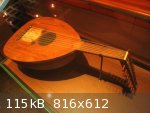
|
|
|
jdowning
Oud Junkie
    
Posts: 3485
Registered: 8-2-2006
Location: Ontario, Canada
Member Is Offline
Mood: No Mood
|
|
The attached rough sketch illustrates four possible styles of 'notched' bridge found on early guitars/vihuelas. The notches may be cut either straight
across the bridge (as in Type 3 and 4) or at a slope (as shown in Types 1 and 2).
The Brussels oud is in the style of Type 1.
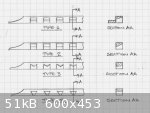
|
|
|
bulerias1981
Oud Junkie
    
Posts: 763
Registered: 4-26-2009
Location: Beacon, NY
Member Is Offline
Mood: John Vergara Luthier Lord of the Strings instrument making and repair
|
|
I feel like I'm missing some information. But what is that image of there? ( http://www.mikeouds.com/messageboard/files.php?pid=82881&aid=19... )
I'd like to know more about this instrument.
|
|
|
jdowning
Oud Junkie
    
Posts: 3485
Registered: 8-2-2006
Location: Ontario, Canada
Member Is Offline
Mood: No Mood
|
|
It is an image of oud #0164 in the Brussels MIM - as noted in my previous post. Didn't you copy the rosette design on your project "Oud #1" on this
forum?
For more information do a Search for oud #0164.
|
|
|
bulerias1981
Oud Junkie
    
Posts: 763
Registered: 4-26-2009
Location: Beacon, NY
Member Is Offline
Mood: John Vergara Luthier Lord of the Strings instrument making and repair
|
|
Ah, ok. This is that one. I realized something familiar about it. I hadn't seen the instrument from this angle. It would be great to hear it!
|
|
|
jdowning
Oud Junkie
    
Posts: 3485
Registered: 8-2-2006
Location: Ontario, Canada
Member Is Offline
Mood: No Mood
|
|
For interest the attached image shows traces left by the original bridge on the so called 'Paris Vihuela' one of the very few surviving 16th C
vihuelas.
It can be seen from the footprint that the bridge was a 'cut out' design - probably either Type 2 ,Type 3 or Type 4.

|
|
|
Sazi
Oud Junkie
    
Posts: 786
Registered: 9-17-2007
Location: Behind my oud
Member Is Offline
Mood: مبتهج ; ))
|
|
Quote: Originally posted by jdowning  | The Brussels #0164 oud may be one of the oldest surviving ouds.
It has several interesting features one being the bridge design...
...This feature may imply a connection of the Brussels oud with earlier Moorish 'Spain' oud making traditions. |
Two thoughts come to mind...
1) Is it the original bridge?
2) If it is, perhaps the maker had seen a vihuela and copied the idea?
|
|
|
jdowning
Oud Junkie
    
Posts: 3485
Registered: 8-2-2006
Location: Ontario, Canada
Member Is Offline
Mood: No Mood
|
|
Thanks for your comments Sazi.
As far as I can tell the bridge appears to be original and is almost identical to the bridge on the oud in Napoleon's 'Description de l'Egypte' - see
attached image.
The date of the Brussels oud may be late 18th C/ early 19th C so it is unlikely that the maker ever saw a Spanish vihuela - an instrument that had
become obsolete before the end of the
16th C. Three instruments that survive - considered to be vihuelas - have the narrow bridge style Type 2 or 3 (possibly 4) - not Type 1 with the extra
material added to increase the gluing area of the bridge. Type 1 however can be found on some of the 17th C guitars. The 16th Spanish guitar was a
'cut down' version of the vihuela (4 courses instead of 5 or 6) from which the guitars of later periods were developed. No early 4 course guitars
survive so it is not possible to confirm their style of bridge.
Spanish luthiers were also making lutes in the 16th C but none survive - lutes that likely may have had their design based upon earlier oud design?
Hard to know for sure without surviving artifacts.
My guess is that some of the Moorish oud makers settled in areas along the North African coast after being expelled from Christian Spain between the
13th and 16th C and so perpetuated their oud making traditions that may have differed in some details from those of the Middle East. The bridge design
on the Brussels oud, therefore, may have originated in that design tradition. Perhaps this type of bridge can still be found on some of the old
surviving ouds from that region - the 'oud arbi' for example?
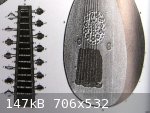
|
|
|
jdowning
Oud Junkie
    
Posts: 3485
Registered: 8-2-2006
Location: Ontario, Canada
Member Is Offline
Mood: No Mood
|
|
The oud arbi does appear typically to have this 'moustachioed' style of bridge.
For information here is a little tutorial about the oud arbi given by Mouats Hafid. It is in French but Mr Hafid speaks with clarity.
http://wn.com/MrMAFID
The oud arbi is modern style - i.e. unfretted - and it is not possible to see if the bridge is drilled or slotted but most likely the former. Note
the white position markers on the side of the neck.
|
|
|